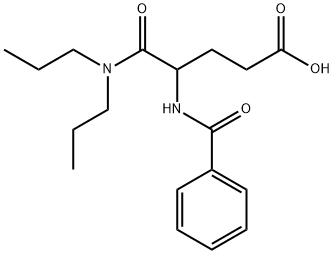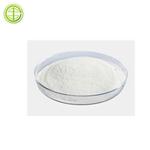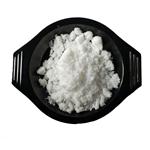Proglumide (Milid) is a drug that inhibits gastrointestinal motility and reduces gastric secretions. It acts as a cholecystokinin antagonist, which blocks both the CCKA and CCKB subtypes. It was used mainly in the treatment of stomach ulcers, although it has now been largely replaced by newer drugs for this application.
Proglumide is a nonpeptide and orally active cholecystokinin (CCK)-A/B receptors antagonist. Proglumide selective blocks CCK’s effects in the central nervous system (CNS). Proglumide has ability to inhibit gastric secretion and to protect the gastroduodenal mucosa. Proglumide also has antiepileptic and antioxidant activities.
ChEBI: Proglumide is a racemate composed of equal amounts of (R)- and (S)-proglumide. A non-selective CCK antagonist that was used primarily for treatment of stomach ulcers, but has been replaced by newer drugs. It has a role as a drug metabolite, a xenobiotic metabolite, a cholinergic antagonist, an anti-ulcer drug, a cholecystokinin antagonist, a gastrointestinal drug, a delta-opioid receptor agonist and an opioid analgesic. It contains a (R)-proglumide and a (S)-proglumide.
An interesting side effect of proglumide is that it enhances the analgesia produced by opioid drugs, and can prevent or even reverse the development of tolerance to opioid drugs. This can make it a useful adjuvant treatment to use alongside opioid drugs in the treatment of chronic pain conditions such as cancer, where opioid analgesics may be required for long periods and development of tolerance reduces clinical efficacy of these drugs.
Proglumide has also been shown to act as a δ-opioid agonist, which may contribute to its analgesic effects.
Moderately toxic by severalroutes. An experimental teratogen. When heated todecomposition it emits toxic fumes of NOx.
This anticholinergic agent (FWfree-acid = 334.42 g/mol; CAS 6620-60-6), also known as DL-4-benzamido-N,N-dipropylglutaramic acid and 4- (benzoylamino)-5-(dipropylamino)-5-oxopentanoic acid, is a cholecystokinin receptor antagonist. Proglumide A also exerts an inhibitory effect on gastric secretion and reduces gastrointestinal motility. It finds use clinically as a therapy for gastrointestinal ulcers. Target(s): cholecystokinin receptor; gastrin receptor.



